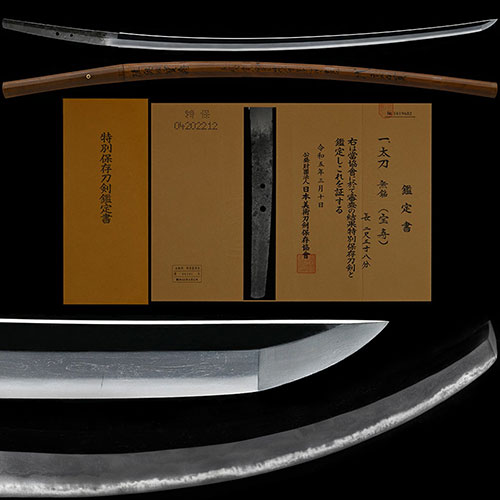
宝寿 太刀 Houju Tachi
No.012123宝寿 舞草鍛治 生ぶ茎太刀 平安末期元暦頃 光遜鞘書 足葉頻りに入り金筋頻りに掛り匂口明るい傑作 二尺五寸八分Houju Mogusa-Kaji Ubu Nakago Tachi Late Heian period, around the Genryaku period, Kouson Sayagaki There are many Ashi and You, Kinsuji-shikirinikakari, Nioikuchi is bright A Masterpiece 78.1cm
ご成約Sold
- 極めKiwame
- 宝寿Houju
- 登録証Registration
- 大阪府 Osaka 昭和40年4月6日 4/6/40(Showa)
- 法量Size
-
刃長 78.1cm ( 二尺五寸八分) 反り 2.3cm
元幅 3.1cm 先幅 2.0cm 元重 0.65cm 鎬厚 0.77cm 先重 0.56cm 鋒長 3.5cm 茎長 24.1cm 重量 910gHachou 78.1cm ( 二尺五寸八分) Sori 2.3cm
Moto-Haba 3.1cm Saki-Haba 2.0cm Moto-Kasane 0.65cm Shinogi-Thikess 0.77cm Saki-Kasane 0.56cm Kissaki-Chou 3.5cm Nakago-Chou 24.1cm Weight 910g - 国Country
- 陸奥Mutsu
- 姿Shape
- 鎬造、庵棟、身幅広く、反り深く、腰反り踏ん張り付き、中鋒。Shinogidukuri, Iorimune, Wide Mihaba, Deep Sori, Koshizori Funbari-tsuki, Chu-Kissaki
- 鍛Kitae
- 板目肌に、杢目交じり、地沸微塵につき、地景入り、映り立つ。Itamehada, Mixed Mokume, Jinie enetered finely, Chikei entered, Utsuritatsu.
- 刃文Hamon
- 直刃調に、小互の目・小乱れ交じり、湯走り・飛び焼き掛かり、小足・葉頻りに入り、小沸深くつき、金筋頻りに掛り、匂口明るく冴える。Suguha-style, Small-Gunome, Mixed small-Mid are, Yubashiri, Tobiyaki-kakari, There are many Small-Ashi and You, Small-Nie entered deeply, Kinsuji-shikirinikakari, Nioikuchi is bright and clear.
- 帽子Boushi
- のたれ込んで小丸、先掃き掛る。Notarekonde-Komaru, Sakihakikakeru.
- 茎Nakago
- 生ぶ、先栗尻、鑢目切、目釘孔二。Ubu, Sakikurijiri, Yasurimegiri, Mekugiana are two(2)
- ハバキHabaki
- 木(柄一体)Wood(Integrated handle)
- 説明Drscription
- 舞草(もぐさ)鍛冶は、平安中期に陸奥で起こった反乱討伐の前九年の役、五三年の役の後より、寛治元年(1087年)頃から奥州藤原氏の繁栄の元で、平泉で名工を輩出しており、古備前正恒の父も舞草鍛冶であったとという。舞草鍛冶には、在銘作が非常に少なく、在銘作が現存しているのは宝寿のみとなる。宝寿は、舞草鍛冶の代表工で、平安末期に源義経を育てた藤原秀衡の頃から鎌倉時代にかけて平泉で活躍した。この刀は、生ぶ茎の作刀時の姿を留めた希少なもので、78cmを超える長さに、身幅3.1cmあり、反り深く、腰反り・踏ん張り付く豪壮な太刀姿で、常と違い詰んだ板目肌に杢目交じる美しい地鉄に、直刃調に、小乱れ・小互の目交じり、小足・葉頻りに入り、小沸深くつき、金筋頻りに掛り、匂口明るい古備前のような出来の傑作である。Mogusa smithing began in the middle of the Heian period, after the 9-year war and the 53-year war to suppress the rebellion that occurred in Mutsu, and from around 1087 under the prosperity of the Oshu Fujiwara clan. , Hiraizumi produced master craftsmen, and it is said that the father of Ko-Bizen Masatsune was also a Mogusa smith. There are very few works with signatures in Mogusa blacksmiths, and Hoju is the only one with signatures. Hoju was a representative blacksmith of
Mogusa, and was active in Hiraizumi during the late Heian period when Fujiwara no Hidehira raised Minamoto no Yoshitsune.
This sword is a rare one that retains the appearance of Ubu Nakago when it was made.
It is over 78cm long and 3.1cm Mihaba, Deep Sori, Koshizori and Funbaritsuku, In a magnificent Tachi appearance. Unlike usual, the beautiful Jigane mixes with Tsunda-Itamehada and Mokume.
It is a masterpiece with a Suguha-style, Small-Midare, Mixed small-genome, There are many small-Ashi and You, Small-Nie entered deeply, Kinsuji-shikirinikakari, Nioikuchi is bright It looks like a bright Kobizen.


